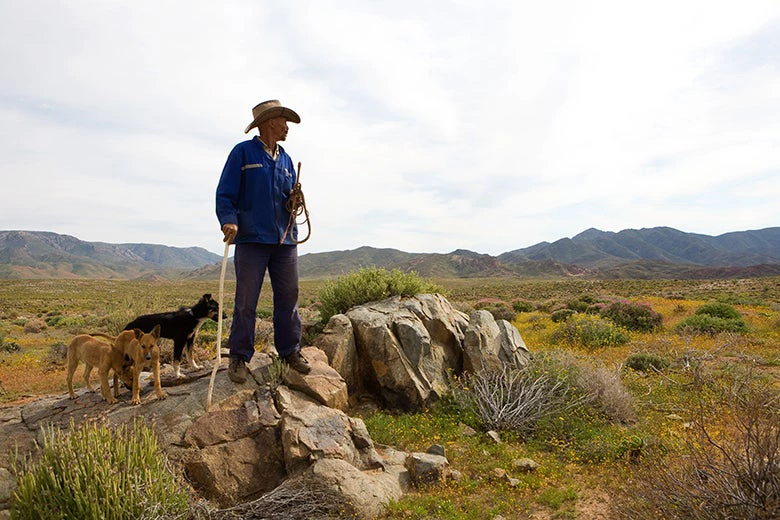 Richtersveld Community Conservancy, à la frontière sud du parc national du Richtersveld, dans la province du Cap-du-Nord, en Afrique du Sud. © John Hogg / Banque mondiale
Richtersveld Community Conservancy, à la frontière sud du parc national du Richtersveld, dans la province du Cap-du-Nord, en Afrique du Sud. © John Hogg / Banque mondiale
This charter became even more urgent with the release of a landmark report that provided stark warnings about the state of our ecosystems and biodiversity, the building blocks of the living environment we all thrive on. The report by the Intergovernmental Science-Policy Platform on Biodiversity and Ecosystem Services (IPBES), warned that one million animal and plant species are threatened with extinction, many within decades. Adding to this bad news, natural ecosystems have declined by an average of 47 percent since earlier estimates and human actions have significantly altered three-quarters of the land-based environment and about 66 percent of the marine environment.
We are used to grim reports but this one stands out as it shows how human health, natural wealth and livelihoods are inextricably linked. Nature’s ability to provide clean water and food security is in jeopardy, threatening the very existence of human life. Land use change is emerging as the biggest factor driving this race to the bottom. We are replacing forests with agriculture, draining wetlands for infrastructure, cutting grasslands for more intensive crops and overfishing our oceans. Since 1980, more than half of the increase in agriculture has been at the expense of intact forests and only 3 percent of the ocean is free from human pressure, according to the IPBES report.
It is no longer about rich and poor countries. All people on this planet will suffer but the poor more so, reversing the gains we have made on poverty reduction in the last few decades. The report rightly calls for 'transformative change'. What can we do about this? The following five steps are a good start:
1. Move beyond GDP and look at the full contribution of nature to the economy
GDP does not capture the impact of development on natural assets that are key to human well-being. On paper, cutting down a forest might raise GDP but the permanent losses in ecosystems services are not counted. So far, only a handful of countries are fully able to treat their natural capital as an asset at par with their built assets, such as infrastructure, and their financial capital, but more are coming on board with this approach. The World Bank is supporting countries to capture the full contribution of natural capital through the Global Program for Sustainability (successor to the Wealth Accounting and Valuation of Ecosystem Services WAVES program). The Bank is also working on an updated version of The Changing Wealth of Nations, which will give greater emphasis to the quality of natural capital and ecosystems services, as well as the policy applications and implications for a more sustainable future.
2. Examine trade-offs to manage multiple demands on resources
Policymakers are faced with hard decisions – whether to convert a piece of forest into land for agriculture to meet growing needs, or for energy production, infrastructure –while at the same time having to think about coastal protection, air quality, water retention and biodiversity for pollinators. We need a systems thinking approach where we look at landscapes as a system and adopt integrated management strategies. For example, building a new road could have devastating costs for forests and biodiversity. Improved assessment techniques that capture the economic and bio-physical synergies and trade-offs could be used to guide these investments and make informed decisions on infrastructure design and associated land-use changes.
3. “Greening” of Public Policies
Mismanagement of natural resources can be controlled by fiscal or market instruments such as carbon or pollution permit trading, or the repurposing of harmful subsidies towards good environmental practices (one example is Payment for Ecosystem Services schemes). More thinking needs to go into these market-based instruments. Governance such as clear property rights (use, transfer, access and exclusion) in land, forests and the eco-system services, global (e.g., carbon sequestration) or local (e.g., pollination), they provide, are the foundations of our economies. Without clarifying the rights, or lack thereof, to pollute, destroy forests and ecosystem services, the unsustainable outcomes we observe will continue unabated. Another step would be to provide better information and analysis for the financial markets to enable them to incorporate environmental risks and impacts in investments and risk ratings and require improved environmental –including climate change-- disclosure standards from private investors and producers alike.
4. Find innovative ways to finance biodiversity
Paying for biodiversity makes economic sense. The Convention on Biological Diversity (CBD)’s Strategic Plan for Biodiversity 2010-2020 estimated the cost of implementing the 20 Aichi Targets at $150-$440 billion per year. This estimate is very limited when weighed against the economic benefits of natural capital. Pollination services alone, for example, are valued at $235-$577 billion (2015 USD) and are said to contribute to 35 percent of the global crop production volume. The question is who would bear the costs? Because much of the observed biodiversity loss ultimately comes from the way we produce, consume, trade and dispose, the bulk of the action will come from changing the behavior of consumers, producers and investors. Greening public policies will help create the market conditions for the self-financing of sustainable bio-diversity management. Cash flow constraints – that is, finding the money now to benefit us in the future— can be overcome through innovative finance. A decade ago, the World Bank’s first Green Bond created the blueprint for what is today a US$500+ billion market. Similar innovative financing mechanisms –in the insurance industry, impact financing, securitization—can and are being developed to finance the “missing middle”.
5. As citizens, let’s reuse, recycle and rethink how we use our finite resources
Plastic pollution has increased ten-fold since 1980. Every year we dump 300-400 million tons of heavy metals, solvents, toxic sludge and other wastes into the waters of the world. We need a circular economy approach – one where waste becomes value and resources are used sustainably. This means that we reuse and recycle everything that we take from our finite resources.
We are working closely with our partners to prepare the post-2020 global biodiversity framework under the auspices of the Convention on Biological Diversity (CBD). The new framework will be adopted at the CBD COP15 in China next year. This is our chance to put some of these steps into commitments and actions and come up with a `new deal for nature’. The G7 Environment Ministers meeting and the agreed Charter was an encouraging sign that biodiversity is getting the attention it deserves.


Join the Conversation